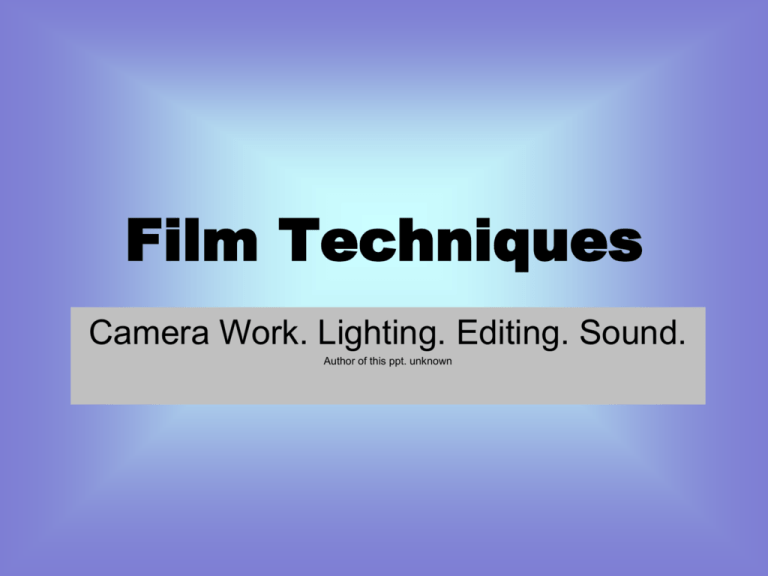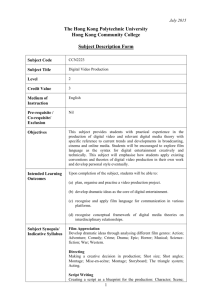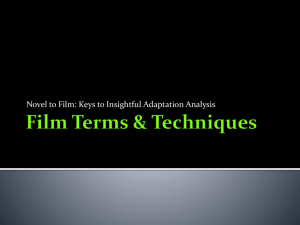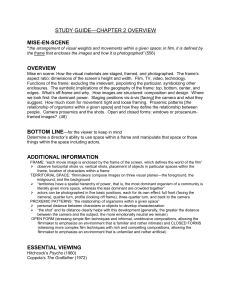Film Techniques
advertisement

Film Techniques Camera Work. Lighting. Editing. Sound. Author of this ppt. unknown Camera Work • The term “camera work” covers several different areas: • • • • Camera shots Camera angles Camera movement Camera focus Camera Shots • Extreme Close Up (ECU) shows detail • Close Up (CU) shows emotion • Medium Close Up (MCU) reactions • Medium Shot (MS) relationships • Medium Long Shot (MLS) body language • Long Shot (LS) shows action • Establishing Shot (ES) sets the scene Identify which Camera shots are used here Establishing shot Long shot Extreme Close Up Medium Close up Close Up Camera Angles Overhead shot High angle shot Low angle shot Mid angle shot Camera Angles Makes the object looks small and insignificant. Suggests vulnerability. Makes the objects look very small, vulnerable or mechanical. Makes streets look like a maze. The most normal angle. Suggests “real life”. The camera is your eyes. Makes the object look large and powerful. Suggests dominance. Camera Movement The camera can be moved in different ways to create different effects. • Pan – camera is fixed but moves side to side • Tilt – camera is fixed but moves up and down • Zoom – camera moves in and out of the same shot. • Track – camera is mounted on a railway track and moves along with what it’s filming. • Crane – camera moves above ground level. Camera Focus • Focus = Clearly highlights to the viewer which subject is important • Soft focus = can suggest romance, poor vision, or substance abuse. • Hard focus = most common in filming as it shows detail of the subject. Lighting • Lighting helps create a mood for a scene. • Different types of lighting include: • Dark / Bright / Warm • Soft light / High contrast • High key / low key DARK VS BRIGHT Dark or dim lighting can create suspense or suggest evil. Light or bright light can create peacefulness or suggest happiness. Back light – creates a silhouette effect. Low Key light – shows detail. Can suggest the subject is evil. High Key light – shows the source of the light (e.g. from the window). Can suggest the subject is good/angelic. Fill light – used to eliminate shadow and create softness. What kinds of lighting are used to create the images below? Mid key back light Back light What kind of lighting do you think is used the most in film? Colour • Colour also helps create a mood for a scene. • Colours can be achieved in different ways: – Coloured lights – Filters in front of the camera – Different film stock – Added at post production ‘Sin City’ (2007) Used black and white with only very important details in red and yellow. (E.g. lipstick, blood). ‘Gattaca’ (1997) Used a warm sepia tone to contrast with the sterile environment. Editing Editing is the way the film is put together. E.g. inclusion, length and order. The sequences of shots then must be arranged to form an entire film. “Film editing is an art form which can either make or break a film.” Pace Think of editing as a heartbeat. • The faster the pace (shorter length shots), the more excitement and action. • The slower the pace (longer length shots) the more serious or detailed. Editing - Transitions • There are a number of ways two scenes can be connected: • Straight cut – one scene is directly after another image • Dissolve – One image merges into another • Wipe - One image is replaced by another with a distinct edge that forms a shape. • Fade – (to black) indicates the end of a scène • Crosscutting – two lines of actions are cut between to show they are happening at the same time. Editing - Montage •A series of short shots edited together to condense a part of the story. Montages suggest the passing of time. •In most cases montages show the main character learning or improving skills that will help achieve the ultimate goal. •A song usually plays in the background to enhance the mood. “Show a lot of things happening at once Remind everyone of what's going on And with every shot you show a little improvement To show it all would take too long That's called a montage Oh we want montage” - ‘Team America’ •Perhaps the most famous montage is from the movie ‘Rocky’. •Or….. ‘The Karate Kid’. http://www.youtube.com/watch?v=IlQOmO44_bA Sound The soundtrack is a vital part of any film and helps it tell its story. It can be broken down into different areas. •Dialogue •Voice Over •Music •Natural sound (diegetic) •Sound Effects (non diegetic) Sound - Dialogue Dialogue is the words of the actors. It is important as it helps us understand the story and characters. The dialogue from some films is so memorable, people are still quoting it today. “Frankly my dear I don’t give a damn!” “Life is like a box of chocolates. You never know what you're gonna get.” “I’ll be back!” Sound Voice Over This is another way words are used to tell the story but the narrator is not seen. Their voice is over the image. Music Music is a powerful technique to elicit emotions. Music should complement the story and help create atmosphere. E.g. Jaws Sound •Natural sound (diegetic) Any sounds that were actually there when filming. (E.g. the sound of the surf, the actor’s voices, the trees rustling, cars passing). •Sound Effects (non-diegetic) These are any sounds added after filming. They are usually used to create atmosphere. (E.g. a door creaking, police sirens, voice over, music.)




